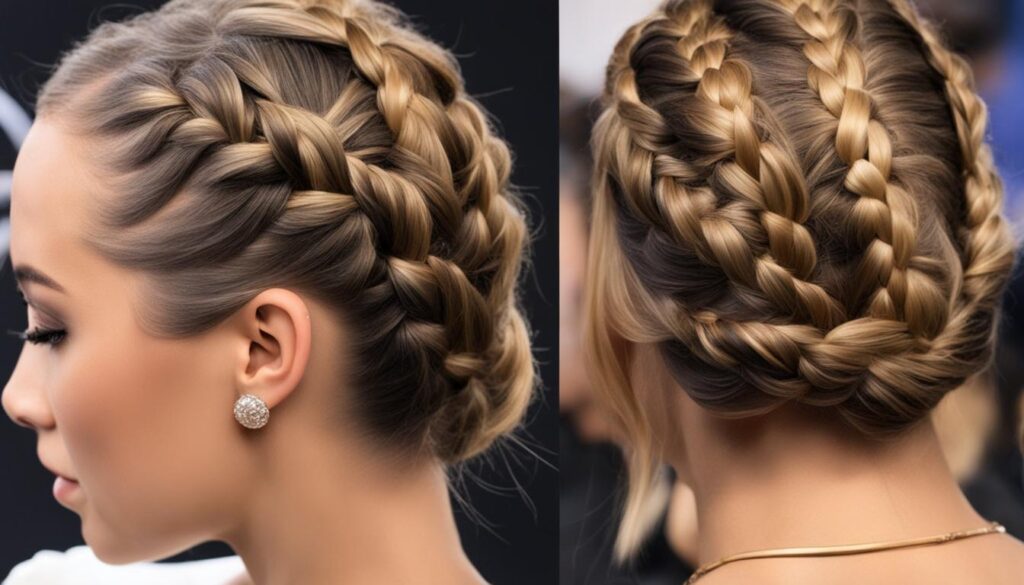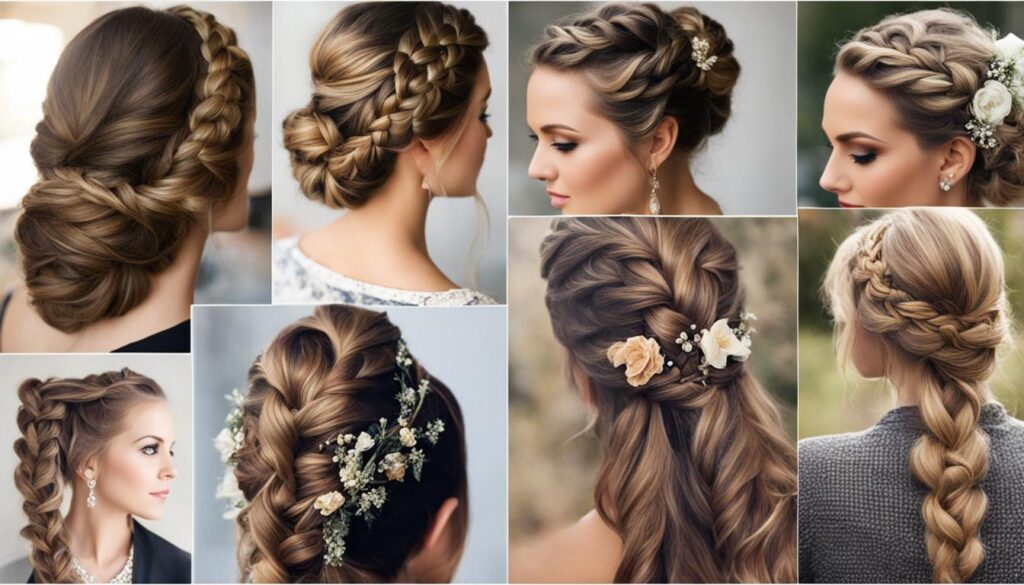
Dutch braids, also known as 3D braids or reverse braids, are a unique style of hair braiding that involves crossing the sections of hair under, rather than over, each other to create a plait that pops out. They can be adapted to any occasion and work well for all hair types. In this article, I will explore various Dutch braid hairstyles and provide step-by-step instructions on how to achieve them.
Key Takeaways:
- Dutch braids are a distinctive style of hair braiding, featuring crossing the sections of hair under instead of over.
- They are versatile and suitable for all hair types and occasions.
- Creating Dutch braids involves adding small sections of hair to each strand as you continue to cross them under.
- They can be achieved on both short and long hair, offering various styling options.
- Perfecting Dutch braids requires practice and patience.
How to Do Dutch Braids: A Step-by-Step Tutorial
Learning how to create Dutch braids is easier than you might think. Follow this step-by-step tutorial to achieve flawless Dutch braids, whether you’re a beginner or looking to perfect your technique.
To start, divide your hair down the middle and separate it into two sections. Take the section on one side and divide it into three equal strands.
- Step 1: Cross the right strand under the middle strand.
- Step 2: Cross the left strand under the new middle strand.
- Step 3: Add small sections of hair to each strand as you continue crossing them under.
- Step 4: Repeat this process until you reach the nape of your neck.
- Step 5: Finish off with a regular braid and secure with an elastic.
Repeat the same steps on the other side to create symmetrical Dutch braids.
Quick Tips for Perfecting Dutch Braids:
- Practice makes perfect: Don’t be discouraged if your first attempt doesn’t turn out exactly as you envisioned. Keep practicing, and you’ll get better over time.
- Use clean, dry hair: Dutch braids work best on clean, dry hair. If your hair is oily or greasy, consider washing and drying it beforehand.
- Part your hair evenly: Make sure to create a straight and even part down the middle of your head to ensure symmetrical braids.
- Take your time: Dutch braids require precision and attention to detail. Take your time while crossing the strands and adding in new sections to achieve a polished look.
With these step-by-step instructions and helpful tips, you’ll be able to master the art of Dutch braids in no time. Practice, experiment with different hairstyles, and embrace the versatility of this classic braiding technique.
Dutch Braid Hairstyles for Short Hair
Contrary to popular belief, Dutch braids can be achieved even on short hair. While it may require some adjustments, this versatile hairstyle can add texture and style to shorter hairstyles. One option for short hair is to create two baby braids on the top and at the side of your head, creating a chic half-up, half-down look. These small Dutch braids can add a touch of elegance and charm to your short hair.
Another way to incorporate Dutch braids into short hair is by creating a small braid at the front of your hairline and securing it with bobby pins, while leaving the rest of your hair loose. This adds a playful and stylish element to your overall look. Dutch braids can enhance the beauty of short hair, making it a versatile option for those with shorter hairstyles.
With a little creativity and a willingness to experiment, you can find a Dutch braid style that suits your short hair perfectly. Don’t be afraid to play around with different variations and accessories to make your Dutch braids unique to your personal style.
“Contrary to popular belief, Dutch braids can be achieved even on short hair.”
Tips for Styling Dutch Braids on Short Hair
- Start with clean, dry hair to ensure better hold and manageability.
- Use a fine-toothed comb to create a clean parting for your braids.
- Make sure to secure the ends of your braids tightly to prevent them from unraveling.
- If you have layers in your short hair, incorporate them into your braids for added texture and dimension.
- Experiment with different accessories such as hairpins, ribbons, or flowers to add a personal touch to your Dutch braid hairstyle.

| Dutch Braid Hairstyles for Short Hair | Description |
|---|---|
| Chic Half-Up, Half-Down | Create two baby Dutch braids on the top and at the side of your head, securing them with bobby pins. Leave the rest of your hair loose for a trendy and feminine look. |
| Front Braid with Loose Hair | Part your hair to the side and create a small Dutch braid at the front of your hairline. Secure it with bobby pins and leave the rest of your hair loose for a playful and stylish look. |
| Textured Pixie Braid | If you have a pixie cut, incorporate a small Dutch braid at the front or side of your hair for added texture and dimension. This style adds a touch of bohemian chic to your short hairstyle. |
With these tips and hairstyle ideas, you can confidently rock Dutch braids on your short hair. Embrace the versatility of this braiding technique and let your creativity shine through!
Dutch Braid Hairstyles for Long Hair
Dutch braids are not only versatile but also look stunning on long hair. The length of the hair allows for endless possibilities in styling, making it a popular choice for those with longer locks. There are various Dutch braid hairstyles that you can try to enhance the beauty of your long hair.
Braided Bun
One of the most elegant and sophisticated Dutch braid hairstyles for long hair is the braided bun. To achieve this look, divide your hair into four sections and braid each section into a Dutch braid. Once all four braids are done, gather them together at the base of your neck and secure them with a hair tie. Finally, twist the braids into a bun shape and pin it in place. This hairstyle is perfect for formal occasions or when you want to add a touch of glamour to your look.
Braided Pigtails
If you’re looking for a more playful and bohemian-chic hairstyle, try braided pigtails with Dutch braids. Simply divide your hair evenly down the middle and braid each side into a Dutch braid. Leave the rest of your hair loose for a carefree and stylish look. This hairstyle works well for both casual and semi-formal occasions, allowing you to showcase your long, beautiful hair in a unique way.
| Hairstyle | Description |
|---|---|
| Braided Bun | A classic and sophisticated hairstyle where four sections of hair are braided into Dutch braids and tied together at the base of the neck to form a bun. |
| Braided Pigtails | A playful and bohemian-chic hairstyle where the hair is divided evenly down the middle and braided into two Dutch braids, leaving the rest of the hair loose. |
These are just a few examples of Dutch braid hairstyles for long hair. Feel free to experiment and get creative with your own variations. Remember, the key to achieving flawless Dutch braids is practice and patience. With time, you’ll become an expert at creating beautiful and intricate hairstyles that will turn heads wherever you go.
Dutch Braid Variations and Tips
Dutch braids offer endless possibilities for creating unique and stylish hairstyles. With a few variations and some expert tips, you can take your Dutch braids to the next level. Here are some ideas to inspire you:
1. Bubble Ponytail
Add a trendy twist to your Dutch braid by incorporating a bubble ponytail. Start by sectioning off the front hair and braiding it into a Dutch braid. Once you reach the crown of your head, gather the rest of your hair into a high ponytail. Secure the ponytail with an elastic and then use additional elastics at regular intervals down the length of the ponytail to create the “bubbles” effect. This unique hairstyle is sure to turn heads!
2. Crossover Braids
For a sophisticated and elegant look, try the crossover braids variation. Part your hair down the middle and braid each side into a Dutch braid, starting from the front. Instead of braiding all the way to the ends, join the braids at the nape of your neck using bobby pins or an elastic. This style creates a beautiful crisscross effect that adds visual interest to your hairstyle.
3. Voluminous Dutch Braids
If you want your Dutch braids to look more voluminous and eye-catching, here’s a simple tip: gently tug on the hair within the braid to loosen it and make it appear fuller. This technique creates a more textured and noticeable braid. Remember to be gentle when pulling on the hair to avoid causing any damage or discomfort.
| Dutch Braid Variation | Description |
|---|---|
| Bubble Ponytail | Add a trendy twist to your Dutch braid by incorporating a bubble ponytail. |
| Crossover Braids | Create an elegant crisscross effect by joining the Dutch braids at the nape of your neck. |
| Voluminous Dutch Braids | Gently tug on the hair within the braid to make it look fuller and more textured. |
With these tips and variations, you can elevate your Dutch braids and make them uniquely your own. Experiment with different styles, accessories, and hair textures to create stunning looks that suit any occasion. Remember, practice and patience are key to perfecting your Dutch braids. Happy braiding!
Dutch Braids for Every Occasion
Dutch braids are known for their versatility and can be worn for various occasions. Whether you’re heading to a casual brunch or attending a formal event, there is a Dutch braid hairstyle that will suit the occasion perfectly. Let’s explore some versatile Dutch braid hairstyles that you can rock for any event.
Everyday Wear
For your everyday activities, a classic Dutch braid hairstyle is a great choice. It’s simple, chic, and keeps your hair off your face. You can create one or two Dutch braids starting from the front of your hairline and working your way towards the back. This hairstyle is perfect for running errands, going to work, or meeting up with friends for a casual outing.
Formal Events
If you have a special occasion coming up, a braided half-up half-down hairstyle featuring Dutch braids can elevate your look. Start by creating Dutch braids on each side of your head, starting from the front and going towards the back. Once you’ve reached the middle of your head, gather the remaining hair and create a low bun or a ponytail. This hairstyle is elegant, sophisticated, and perfect for weddings or any formal event.
Day to Night Transition
Dutch braids are incredibly versatile and can easily transition from day to night. One stylish option is to create two Dutch braids on either side of your head and join them together at the back to form a beautiful braided crown. This hairstyle works well for both casual and more formal occasions, making it a go-to choice if you’re looking for a seamless day to night transition.
No matter the occasion, Dutch braids offer a wide range of hairstyles to suit your needs. Experiment with different variations, add accessories if desired, and embrace the beauty and versatility of Dutch braids. With a little practice, you’ll be able to master these hairstyles and rock them confidently for any event.

Conclusion
Dutch braids are a versatile and timeless hairstyle that can be enjoyed by anyone, regardless of hair type or length. Whether you’re a beginner or an experienced braider, mastering the art of Dutch braids is within reach.
By following a simple step-by-step tutorial, you can create stunning Dutch braid hairstyles that are perfect for any occasion. From elegant braided buns to bohemian-chic braided pigtails, the options are endless.
Remember, practice makes perfect when it comes to perfecting Dutch braids. Take your time, be patient, and don’t be afraid to experiment with different variations. With dedication and a little creativity, you can achieve flawless Dutch braids that will turn heads wherever you go.
So go ahead, embrace the beauty of Dutch braids and let your hair shine with this captivating and stylish hairstyle.
FAQ
What do Dutch braids look like?
Dutch braids, also known as 3D braids or reverse braids, are unique hairstyles that involve crossing the sections of hair under, rather than over, each other to create a plait that pops out.
How do I do Dutch braids?
To do Dutch braids, start by parting your hair down the middle and dividing it into two even sections. Begin with one section and divide it into three equal strands. Cross the right strand under the middle strand, then cross the left strand under the new middle strand. Repeat this process, adding small sections of hair to each strand as you continue to cross them under. Repeat on the other side for symmetrical Dutch braids.
Can I do Dutch braids on short hair?
Yes, Dutch braids can be achieved even on short hair. The key is to make the braids slightly shorter and smaller than usual. A chic half-up, half-down look can be created by making two baby braids on top and at the side of the head.
How do I do Dutch braids on long hair?
Dutch braids look equally stunning on long hair. One popular hairstyle is the braided bun, where four sections of hair are braided into Dutch braids and tied together at the base of the neck to form a bun. Another option is braided pigtails, where the hair is divided evenly down the middle and braided into two Dutch braids, leaving the rest of the hair loose.
What are some variations and tips for Dutch braids?
Dutch braids offer a wide range of variations. Adding a bubble ponytail to a Dutch braid creates a trendy look, while crossover braids join the braids at the nape of the neck for a unique hairstyle. To perfect your Dutch braids, lightly tug on the hair within the braid to make it look more voluminous and noticeable.
Can I wear Dutch braids for any occasion?
Yes, Dutch braids are versatile and can be worn for various occasions. A classic Dutch braid hairstyle is suitable for everyday wear, while a braided half-up half-down style can be dressed up for more formal events. Dutch braids can effortlessly transition from day to night.






